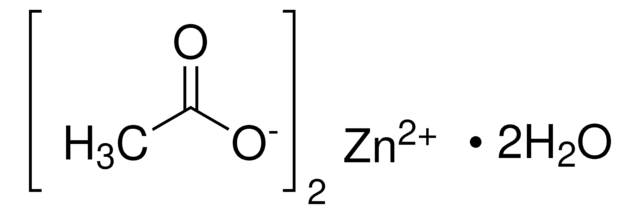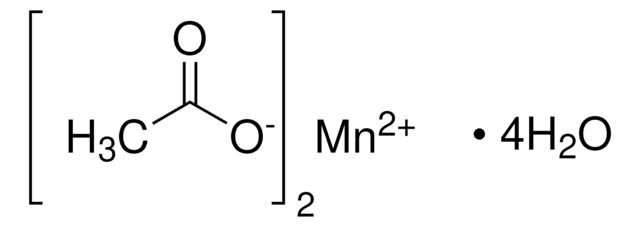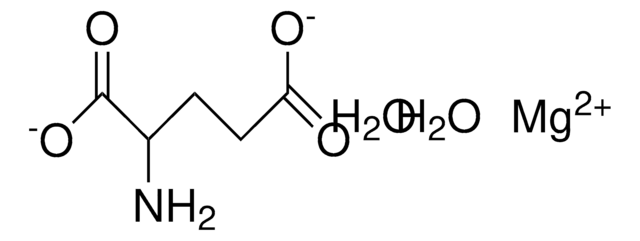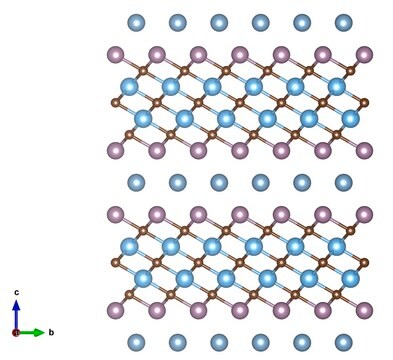939358
Magnesium acetate tetrahydrate

≥99.9% trace metals basis
Sinónimos:
Magnesium Diacetate Tetrahydrate,, Magnesium diethanoate tetrahydrate, Acetic acid magnesium salt
About This Item
Productos recomendados
tpo
(High purity salts)
Nivel de calidad
Ensayo
≥99.9% trace metals basis
98-102% (EDTA, complexometric)
Formulario
powder or crystals
solid
impurezas
<1000 ppm trace metal basis
color
white to off-white
mp
72-75 °C (lit.)
72-75 °C
solubilidad
water: soluble
densidad
1.454 g/cm3
trazas de anión
chloride (Cl-): ≤20 ppm
sulfate (SO42-): <50 ppm
trazas de catión
Al: <50 ppm
K: <50 ppm
Mg: <100 ppm
Na: <50 ppm
Pb: <50 ppm
Zn: <50 ppm
aplicaciones
battery manufacturing
cadena SMILES
O.O.O.O.CC(=O)O[Mg]OC(C)=O
InChI
1S/2C2H4O2.Mg.4H2O/c2*1-2(3)4;;;;;/h2*1H3,(H,3,4);;4*1H2/q;;+2;;;;/p-2
Clave InChI
XKPKPGCRSHFTKM-UHFFFAOYSA-L
¿Está buscando productos similares? Visita Guía de comparación de productos
Descripción general
Aplicación
- A key components for the synthesis of spinel magnesium manganese oxide (Mg0.5Mn2.5O4 ) through one-step colloidal synthesis method. The nanocrystals has exhibited significant electrochemical activities in presence of diverse electrolytes.
- A starting materials for the production of Mesoporous (ZnO)x(MgO)1−x nanoplates by a template-free solvothermal synthetic method followed by subsequent calcination. These materials exhibit a band gap resulting from the presence of ZnO and MgO. The broad peaks observed in the 400-700 nm range indicate the presence of oxygen vacancy defects on the surface of the (ZnO)x(MgO)1−x nanoplates. These nanocrystals showed superior photocatalytic activities for the degradation of methyl orange (MO) in aqueous solution.
- To the synthesis of hydrophobic antireflective films of MgF2 with silicon modified with enhenced durability through sol-gel method.
- As a material for synthesizing carbon nanoribbons using ferrocene at high temperatures. The resulting nanoribbons exhibit a remarkably high surface area and demonstrate a stable reversible capacity of 750 mA h g−1 after 300 cycles in a charge-discharge experiment conducted at 0.5 A g−1. Due to these properties, it would be highly beneficial as an electrode material in electronic devices.
Características y beneficios
Medium purity (99.9%)
Low trace metals in ppm level
Cost effective
Low Chloride and sulfate levels
Código de clase de almacenamiento
11 - Combustible Solids
Clase de riesgo para el agua (WGK)
WGK 1
Punto de inflamabilidad (°F)
Not applicable
Punto de inflamabilidad (°C)
Not applicable
Elija entre una de las versiones más recientes:
Certificados de análisis (COA)
Lo sentimos, en este momento no disponemos de COAs para este producto en línea.
Si necesita más asistencia, póngase en contacto con Atención al cliente
¿Ya tiene este producto?
Encuentre la documentación para los productos que ha comprado recientemente en la Biblioteca de documentos.
Nuestro equipo de científicos tiene experiencia en todas las áreas de investigación: Ciencias de la vida, Ciencia de los materiales, Síntesis química, Cromatografía, Analítica y muchas otras.
Póngase en contacto con el Servicio técnico







